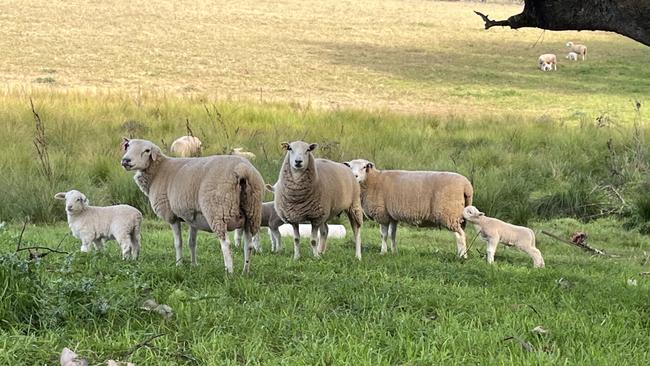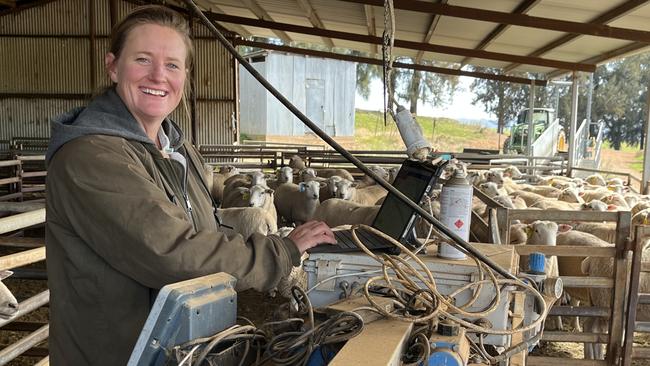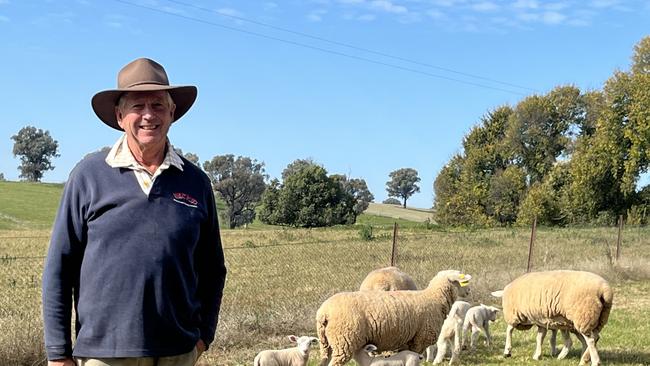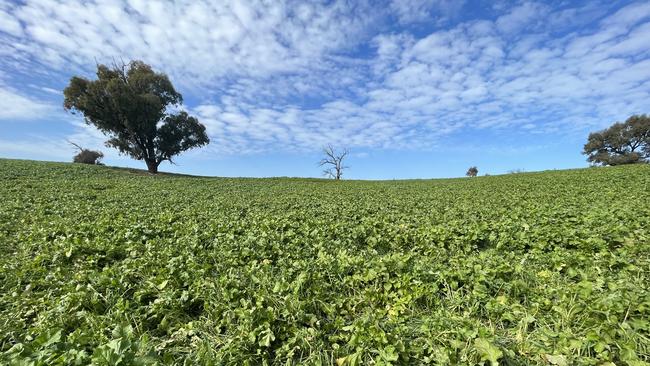Lamb operation is future focused
From butcher to market reporter and lamb buyer, Tony Rutter is drawing on experience to produce market-ready stock.
Turning a profit from prime lambs is all about the data for Riverina sheep breeder Tony Rutter.
Tony has flipped the supply chain on its head, working his way back from consumer to lamb genetic heredity to find an ideal recipe for breeding profitable sheep on his 222ha property at Tarcutta, southeast of Wagga Wagga in NSW.
The enterprise, which specialises in breeding composite sheep, draws on his decades of experience as a butcher, Meat and Livestock Australia market reporter and buyer.
For 40 years, he has walked the saleyard laneways up and down Australia’s east coast as a buyer. At one stage, he was buying as many as 60,000 to 80,000 lambs a year directly from farmers and the balance through saleyards to secure 200,000 head annually for his Oberne feedlot.
Now he is crunching the numbers to make every inch of Avon – the Tarcutta farm with undulating country and sandy loam soils – perform.
A stringent set of criteria backed up by meticulous record-keeping has allowed him to establish Meat Plus composite sheep, which boast high yields and a bare breach that eliminates the need for crutching.

CARCASS GAINS
To make money, Tony says, dressing percentages – or meat yields – are vital. And this is one of the main aims of his Meat Plus breeding program.
According to MLA, the industry dressing percentage average for a 50kg lamb is 47 per cent. Tony aims for lambs with a yield of 52 per cent. He says difference equates to a carcass weight of 26kg compared to the industry average of 23.5kg, or a profit increase of $17.50 per head.
For Tony the composite sheep have combined the best of Texel, Poll Dorset and East Friesian, and more recently has drawn on shedding breeds.
He says the Poll Dorsets have provided market acceptance, East Friesians excellent milk production and propensity for twins, while Texels offer meat characteristics and a bare breach.
Tony has been farming at Tarcutta since 1999 and, until recently, backed up the operation with the nearby feedlot and irrigation country at Berrigan.
The feedlot ran from 2002 to 2015, at its height turning off almost 230,000 lambs annually for the domestic market.
Tony says the feedlot was the impetus for breeding a composite sheep that could perform and provide profits in Australia’s competitive prime lamb industry.

GENETIC SUCCESS
The process of buying in lambs for the feedlot gave Tony an insight into large-scale breeding operations, and he saw the need for high-performing genetics that met the demands of the industry.
He decided to breed rams, building a client base of producers who supplied lambs to the feedlot.
“We want meat quality, carcass shape, structure, growth and fertility combined with ewe doability,” he said.
He started his composite Meat Plus stud in 2008. The “Plus” in Meat Plus stands for prime lamb ultimate solution.
Tony said to improve the quality of the lambs he was purchasing; it was essential to supply rams that could make significant flock improvements quickly.
In addition to improved carcass attributes, he also breeds for better welfare and easier animal management.
The sheep have bare breach and belly, therefore don’t require crutching.
There are plans to shorten the tail to ease management further.
The flock is shorn annually in September and October.
Tony said there was a demand within the industry for sheep without wool. This option is currently being explored by introducing shedding characteristics to some of the Meat Plus lines.
He’s also selecting for worm resistance, black feet and desirable temperament traits.

FERTILITY FOCUS
There are some stringent criteria in the flock. Ewes cannot have more than one “single lamb” in their life. Twins are the aim.
Triplets aren’t desirable due to poor survival rates.
“If you have a cold night, then you could have three dead lambs by the next morning,” he said.
“Twins are also one of the main profit drivers.”
The lambing survival rate last year was an impressive 93 per cent.
Moderate frame size is ideal, with a liveweight of 80kg and a body score of three.
“They need to stay in good condition on moderate feed,” he said.
Lambs are weaned at 14 weeks at a weight of 40kg.
They have an average daily weight gain of 400-500g on pasture and crops.
“As a butcher, you wanted to cut as much meat as possible from a lamb. That’s the profit driver,” he said. “And you can charge accordingly for better meat.”
Kate Hufton of Gundagai in southern NSWmanages the data collection of the flock and uses BreedELITE Sheep software to record traits.
Data from Australian Sheep Breeding Values also plays an integral role in selection.
Tony said it was Kate’s idea to start breeding rams to supply clients and focus on the traits they were selecting.
Kate keeps track of everything from foot colour to worm burden and temperament.
In addition to using data, the sheep are selected visually for structural correctness. And Tony isn’t afraid to cull hard.
One year he had 800 ewes to assess, and of those 600 were culled.

STRENGTH IN NUMBERS
Embryo transfer programs to enhance just the money-making traits, and boost overall flock numbers quickly, have been used to help maintain the flock after stringent culling.
Fertility is vital. Ewes were early maturing and joined at seven to eight months.
He initially started selling the composite rams from this program in 2011.
Now 300 rams a year are sold by private treaty, at eight months for $1850 and weighing 75-80kg.
“I know how many rams my clients need for the next year,” he said.
The Tarcutta property receives an average annual rainfall of 610mm, and there is a strategic focus on grazing crops to boost nutrition requirements for livestock.
Winter feed consists of pasture plus a crop of wheat under-sown with turnips and radish.
There will also be further sowing of vetch this winter.

At any one time, the property supports up to 700 breeding ewes.
The lamb portion of production, not kept for breeders, is turned off direct to processors, Gundagai Lamb or Hardwicks at Kyneton. The lambs are sold at about six months, weighing 24-25kg.
The Tarcutta property provides an ideal environment for breeding lambs. There are shelter belts throughout, and Tony has a policy of planting at least 30 trees a year to replace any that have died and enhance the current shelter.
In addition to the prime lambs Mr Rutter also has an interest in beef cattle. He runs Angus and Shorthorns. He secured a Shorthorn cow for a record-breaking $95,000 price at Sprys Shorthorns on-property sale at Wagga Wagga in April.




